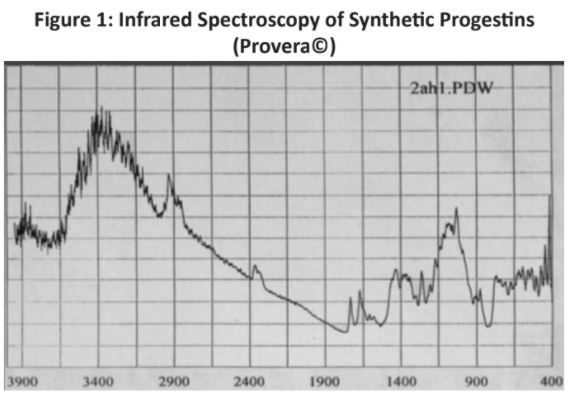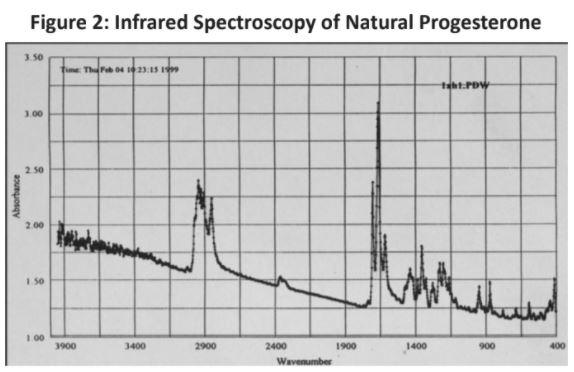by Phyllis Bronson, Biochemical Research Foundation (Aspen, Colorado) and
D. M. Smith, Department of Chemistry and Biochemistry, University of Denver (Denver, Colorado)
The Women’s Health Initiative, a huge randomized study1 on the impact of hormones on women’s health, ignored the statistical relevance of the breakdown of the data; for many years the estrogen and synthetic progestin aspects were lumped together. It was only more recently that independent researchers began to tease apart the data and found that the women using just estrogen, even in a less than perfect form such as Premarin®, fared far better with the areas of gender health issues2 than those on combination therapies utilizing synthetic progestins, not real progesterone. The standard bearer, Provera, which is in fact a progestin, has long replaced natural progesterone; it and indeed all the synthetic analogues block real endogenous or exogenous progesterone from reaching its receptor.3 This same mechanism of action also may block testosterone from properly accessing its receptor – a concern as testosterone is being greatly researched as an anti-cancer molecule.
There is increased concern in the demographic of young women, presenting with serious depression, who have been on birth control often for years. A large Danish study published recently is exemplary of the overarching issue here: the potential impact of birth control pills on major depression.4,5 Women who use hormonal contraceptives are at increased risk for suicide attempt and suicide. The highest relative risk is seen in adolescent women, the Danish study indicates.
The reasons for mood disturbances are most plausibly linked to the fact that synthetic progestin blocks the receptor from accessing the real molecule, thereby inhibiting the calming effect at the GABA-AR, induced by either endogenous or exogenous (transdermal compounded cream) progesterone. Instead of properly opposing excess estradiol from becoming aggressive, synthetics such as MPA (medroxy-progesterone acetate) and all synthetic analogues may block estrogen too much and not allow its often-extraordinary benefits on mood.
There is an important distinction between actual progesterone (which is native and natural to female biology) and progestins, which are the synthetic analogues used pharmacologically in birth control pills, contraceptive devices, and most traditional hormone replacement. (HRT). This is in contrast to B-HRT, which utilizes real progesterone as well as other bioidentical molecules. Progesterone has a calming effect on the nervous system,6 due to the interface of the progesterone molecule and the GABA-AR (receptor) that induces the opening of the chloride ionic channel; this impacts neuroinhibition and is the route to helping anxiety patterns. The way anti-anxiety drugs are developed (benzodiazepines) is predicated on this molecular aspect. Synthetic progestins (ie, medroxy progesterone acetate-MPA and their cousins and analogues) have a very different impact on these mechanisms of action and do not help anxiety.3
The correlation between the structural and clinical evidence-based interpretations from the women who have been treated for anxiety using progesterone and GABA is evident: women using real progesterone report increased calmness and reduced impatience and irritability and an increased sense of general well-being. The latter is thought to be a result of reduced cerebral edema and other water retention due to the opposing effects on hydration between the less hydrophilic progesterone and the more hydrophilic synthetic progestins.

As shown by Figures 1 and 2, the structural differences between the molecules, an additional -CH3 on C-6 (B ring) and the acetate on C-17 (D ring) in the case of the progestin (Provera), are revealed by the infrared spectra7 taken under identical experimental conditions. An intense broad band centered at about 3390 cm-1 is due to hydrogen bonding interactions of the water associated with the hydroxyprogesterone acetate. In contrast, the natural progesterone has virtually no water associated with the molecule. The overwhelming differences in the spectra are due primarily to the amount of water associated with each molecule under the spectroscopic conditions. The medroxyprogesterone acetate is clearly much more hydrophilic than the natural progesterone.

There has been a consistent push to create newer and more improved analogues of women’s hormones. However, the perfect structures may already exist, which are identified as being exactly what the female body produces. Women do better when bioidentical structures are administered in proper balance.
References
- Lobo RO. Where Are We 10 Years After the Women’s Health Initiative. J. Clinical Endochronology, 2013; 98(5): 1771- 1780.
- Bluming A, Tavris C. Estrogen Matters. Hatchette: 2019.
- Friedman Edward. The New Testosterone, (1st ed). Prometheus; 2013.
- Lidegaard O. personal communication to Medscape Medical News, 2017.
- Gaskins M. Birth Control’s Breast Control Curveball. Hormones Matter. June 10, 2019.
- Bronson P, Bronson R. Moods, Emotions and Aging. New York; Rowman Littlefield:2013.
- Chughtai AR, Smith DM (University of Denver). Personal communication; 2015.
Phyllis Bronson, PhD, holds a doctorate in biochemistry. Her ongoing research involves studying the biological impact of molecules on mood and emotion. Dr. Bronson and her medical partner works with women who have hormone-based mood disorders, utilizing her original research on human identical hormones. She lives in Aspen, Colorado, and is president of Biochemical Consulting and The Biochemical Research Foundation.
Dwight Morrell Smith, PhD, served the University of Denver (DU) from 1972-1989 and 1992-2017 as professor of chemistry, academic administrator, and chancellor of the university. He currently is Professor Emeritus and Chancellor Emeritus. His early career included appointments at the Texaco Research Center, Wesleyan University (CT), Hope College (MI), and Scripps Institution of Oceanography (CA). His research has included heterogeneous catalysis, infrared spectroscopy, structure and reactivity of black carbon, and animal-based inhalation studies.







